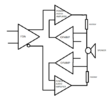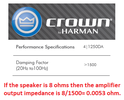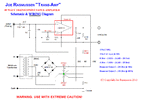Hello everybody .
I'm about to make a very specific request, I need help
to understand if it is a feasible idea as I thought it and try to complete the circuit.
as the title suggests it is an audio power amplifier, the image you see is not to be considered a diagram because other components are missing but it serves as an aid to understanding what I want if words were not enough.
we see an FDA driving 2 bridged power audio chips, the feedback of the latter is made by 1 opamp per branch instead of the usual 2 resistors in series that go to ground.
this feedback must have a precise function, the
loudspeaker current drive .
the concept is to increase the voltage of the amplifier when the impedance of the loudspeaker increases in order to obtain a balance and a constant current, the task of the 2 resistors in series with the loudspeaker, with a value equal to 0.1 Ohm or even less , is to allow the 2 opamps to create a feedback . when the speaker impedance increases the voltage across the 2 resistors decreases and at that point the 2 opamps via feedback must increase the output voltage of the 2 bridged power chips.
why bridge? . because I can get twice the voltage of a ground loop amplifier.
without a bridge and with ground reference it is easier to do , but not with this system .
let's see if in this forum [unlike others] there are people able to succeed in realizing the scheme.
I'm about to make a very specific request, I need help
to understand if it is a feasible idea as I thought it and try to complete the circuit.
as the title suggests it is an audio power amplifier, the image you see is not to be considered a diagram because other components are missing but it serves as an aid to understanding what I want if words were not enough.
we see an FDA driving 2 bridged power audio chips, the feedback of the latter is made by 1 opamp per branch instead of the usual 2 resistors in series that go to ground.
this feedback must have a precise function, the
loudspeaker current drive .
the concept is to increase the voltage of the amplifier when the impedance of the loudspeaker increases in order to obtain a balance and a constant current, the task of the 2 resistors in series with the loudspeaker, with a value equal to 0.1 Ohm or even less , is to allow the 2 opamps to create a feedback . when the speaker impedance increases the voltage across the 2 resistors decreases and at that point the 2 opamps via feedback must increase the output voltage of the 2 bridged power chips.
why bridge? . because I can get twice the voltage of a ground loop amplifier.
without a bridge and with ground reference it is easier to do , but not with this system .
let's see if in this forum [unlike others] there are people able to succeed in realizing the scheme.




